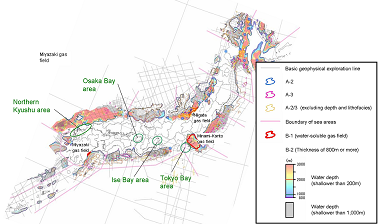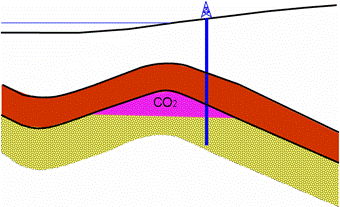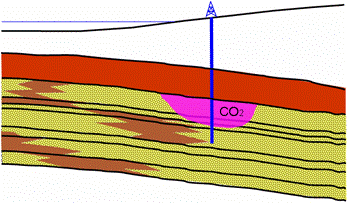 |
 |
|
Survey of Storage Capacity in Japan Purpose To show with confidence that Japan's aquifers have the potential for CO2 storage, the following efficacy evaluations were performed.
Classification of CO2 Geological Storage The potential geological storage capacity was calculated based on the results of geological surveys and newly-obtained technical knowledge on CO2 storage. Storage in aquifers was classified into Category A - "storage in an anticlinal structure" and Category B - "storage in a geological structure with a stratigraphic trapping, etc." Furthermore, considering that the evaluation accuracy of these categories varies according to the quality and quantity of geological data obtained by government-conducted basic surveys (basic drilling and basic geophysical exploration), Category A was classified into three sub-categories (A1, A2, A3) and Category B into two sub-categories (B1, B2). Classification of CO2 storage in deep underground saline formation
Calculation of Storage Capacity Based on the knowledge obtained from the demonstration tests at the Iwanohara site and other actual aquifer storage, the geological storage capacity is calculated using the following equation.
The storage factor, Sf, shows the volumetric ratio of supercritical CO2 storage to the total void volume in the aquifer. In the current survey, considering the vertical migration of CO2 due to buoyancy, 50% was adopted for Category A. As for Category B, 25% was adopted because this category has a wider area than Category A and hence the reservoir is rather non-uniform in the horizontal direction. For the supercritical CO2 saturation (Sg), 50% was adopted in view of: the reference ratio of CO2 saturation derived from geophysical logging at the Iwanohara site was 40-50%, the Sg in a German case was 40-60% (May et al. 2004), and the result of a Canadian simulation was 30-90% (Keith et al. 2004). Using the above equation, the CO2 potential storage capacity in Japan was calculated. The storage capacity derived is 30.1 Gt for Category A and 116 Gt for Category B, which means the total geological storage capacity in Japan is 146.1 Gt. The reasons for the significant increase in capacity compared to the estimate of 1993 (91.4 Gt) are that the geological survey data after 1993 was added, and the ratio of supercritical CO2 storage was increased as a result of re-evaluating the 1993 assumption which considered that CO2 would be stored after dissolved into water. Calculation results of CO2 geological storage capacity
Viability of CO2 Geological Storage near Emission Sources Regarding the effectiveness of geological storage, matching an emission source with a storage site is very important in addition to the availability of storage capacity. This is because cost analysis reveals transport costs account for a relatively large percentage of the total storage costs. If we can show the potential for geological storage near the emission sources, it will significantly facilitate the practical application of this storage method. From the existing data on potential reservoirs and locations in each category in Japan, it is known that deep ground data is not sufficient in areas like Tokyo Bay, Osaka Bay, Ise Bay, and the northern Kyushu area which are close to large-scale emission sources. To evaluate the storage potential in these areas, field surveys such as boring surveys and geophysical exploration by seismic reflection methods need to be performed. Distribution of storable aquifers and related surveys
 Click to enlarge Based on the existing geological data, examination of geological structures, extraction and review of storage reservoirs and seal formations, the potential CO2 storage capacity was estimated with a focus on such areas as Tokyo Bay, Ise Bay, Osaka Bay, and northern Kyushu which are close to large-scale emission sources. This estimation revealed for the first time that these coastal areas located near the large-scale emission sources have the potential for geological storage. Achievements
Future Challenges
|
|||||||||||||||||||||||||||||||||||||||||||||||||||||||||||||||||||||||||||||||||||||||||||||||||||||||||||||||||||||||
|
|||||
|
|


